Analyzing Monopoly and Monopolistic Competition in Australia's Market
VerifiedAdded on 2023/06/05
|12
|2949
|341
Essay
AI Summary
This essay provides an analysis of the market structures in Australia, focusing on monopoly and monopolistic competition. It begins by defining market structure and its various forms, including monopoly, oligopoly, perfect competition, and monopolistic competition. The essay then delves into specific examples of monopoly and monopolistic competitive industries operating in Australia, highlighting the postal service as a monopoly and coffee firms as examples of monopolistic competition. It discusses the reasons behind government intervention in monopoly markets, such as controlling service prices and protecting consumer interests, while explaining the lack of intervention in monopolistic competitive markets to avoid hampering business operations and reducing competition. The essay also touches on the role of the Australian Competition and Consumer Commission (ACCC) and the impact of government policies on these market structures. The analysis further explores the characteristics of each market structure, including pricing mechanisms, barriers to entry, and the potential for firms to earn supernormal profits. The document is available on Desklib, a platform offering AI-based study tools and a wide range of academic resources for students.
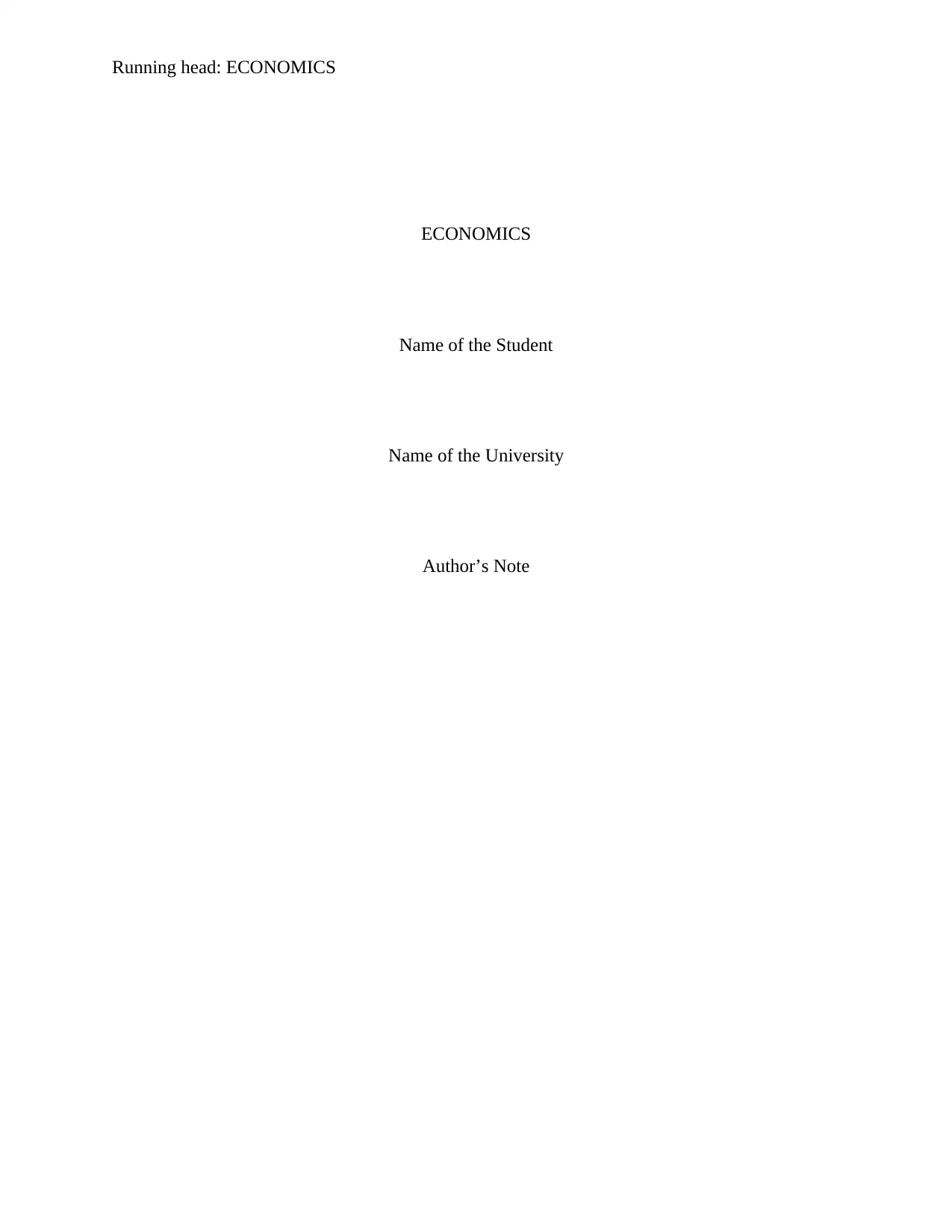
Running head: ECONOMICS
ECONOMICS
Name of the Student
Name of the University
Author’s Note
ECONOMICS
Name of the Student
Name of the University
Author’s Note
Paraphrase This Document
Need a fresh take? Get an instant paraphrase of this document with our AI Paraphraser
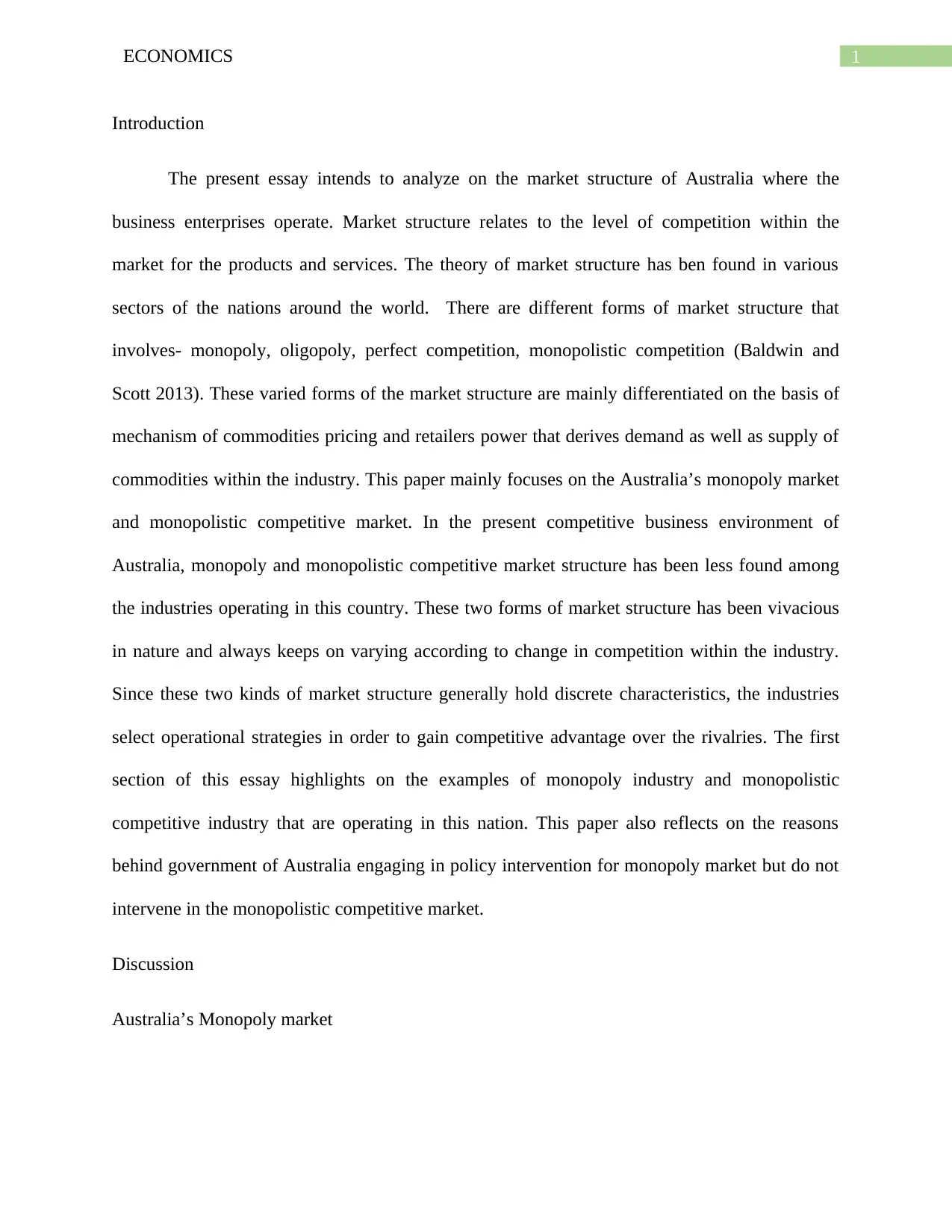
1ECONOMICS
Introduction
The present essay intends to analyze on the market structure of Australia where the
business enterprises operate. Market structure relates to the level of competition within the
market for the products and services. The theory of market structure has ben found in various
sectors of the nations around the world. There are different forms of market structure that
involves- monopoly, oligopoly, perfect competition, monopolistic competition (Baldwin and
Scott 2013). These varied forms of the market structure are mainly differentiated on the basis of
mechanism of commodities pricing and retailers power that derives demand as well as supply of
commodities within the industry. This paper mainly focuses on the Australia’s monopoly market
and monopolistic competitive market. In the present competitive business environment of
Australia, monopoly and monopolistic competitive market structure has been less found among
the industries operating in this country. These two forms of market structure has been vivacious
in nature and always keeps on varying according to change in competition within the industry.
Since these two kinds of market structure generally hold discrete characteristics, the industries
select operational strategies in order to gain competitive advantage over the rivalries. The first
section of this essay highlights on the examples of monopoly industry and monopolistic
competitive industry that are operating in this nation. This paper also reflects on the reasons
behind government of Australia engaging in policy intervention for monopoly market but do not
intervene in the monopolistic competitive market.
Discussion
Australia’s Monopoly market
Introduction
The present essay intends to analyze on the market structure of Australia where the
business enterprises operate. Market structure relates to the level of competition within the
market for the products and services. The theory of market structure has ben found in various
sectors of the nations around the world. There are different forms of market structure that
involves- monopoly, oligopoly, perfect competition, monopolistic competition (Baldwin and
Scott 2013). These varied forms of the market structure are mainly differentiated on the basis of
mechanism of commodities pricing and retailers power that derives demand as well as supply of
commodities within the industry. This paper mainly focuses on the Australia’s monopoly market
and monopolistic competitive market. In the present competitive business environment of
Australia, monopoly and monopolistic competitive market structure has been less found among
the industries operating in this country. These two forms of market structure has been vivacious
in nature and always keeps on varying according to change in competition within the industry.
Since these two kinds of market structure generally hold discrete characteristics, the industries
select operational strategies in order to gain competitive advantage over the rivalries. The first
section of this essay highlights on the examples of monopoly industry and monopolistic
competitive industry that are operating in this nation. This paper also reflects on the reasons
behind government of Australia engaging in policy intervention for monopoly market but do not
intervene in the monopolistic competitive market.
Discussion
Australia’s Monopoly market
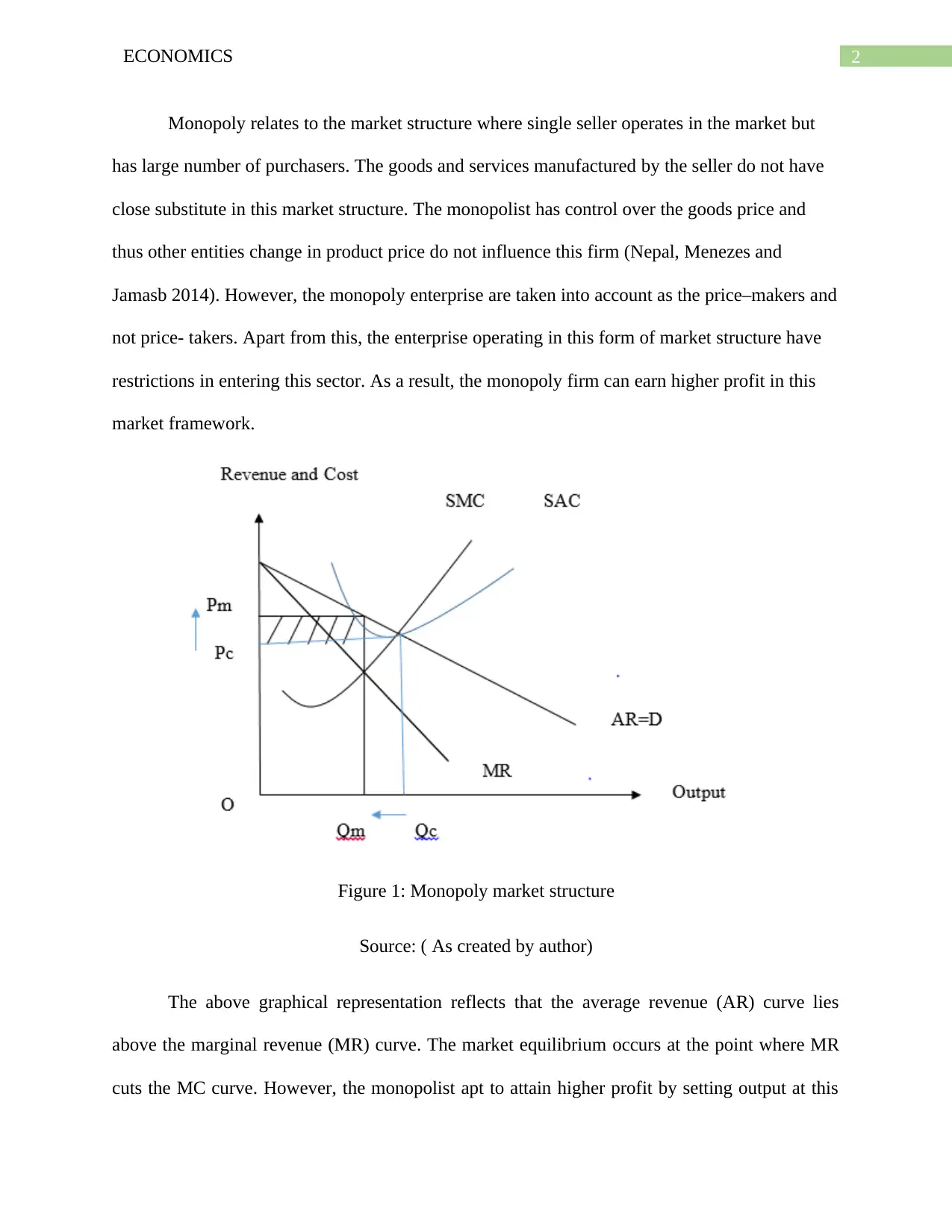
2ECONOMICS
Monopoly relates to the market structure where single seller operates in the market but
has large number of purchasers. The goods and services manufactured by the seller do not have
close substitute in this market structure. The monopolist has control over the goods price and
thus other entities change in product price do not influence this firm (Nepal, Menezes and
Jamasb 2014). However, the monopoly enterprise are taken into account as the price–makers and
not price- takers. Apart from this, the enterprise operating in this form of market structure have
restrictions in entering this sector. As a result, the monopoly firm can earn higher profit in this
market framework.
Figure 1: Monopoly market structure
Source: ( As created by author)
The above graphical representation reflects that the average revenue (AR) curve lies
above the marginal revenue (MR) curve. The market equilibrium occurs at the point where MR
cuts the MC curve. However, the monopolist apt to attain higher profit by setting output at this
Monopoly relates to the market structure where single seller operates in the market but
has large number of purchasers. The goods and services manufactured by the seller do not have
close substitute in this market structure. The monopolist has control over the goods price and
thus other entities change in product price do not influence this firm (Nepal, Menezes and
Jamasb 2014). However, the monopoly enterprise are taken into account as the price–makers and
not price- takers. Apart from this, the enterprise operating in this form of market structure have
restrictions in entering this sector. As a result, the monopoly firm can earn higher profit in this
market framework.
Figure 1: Monopoly market structure
Source: ( As created by author)
The above graphical representation reflects that the average revenue (AR) curve lies
above the marginal revenue (MR) curve. The market equilibrium occurs at the point where MR
cuts the MC curve. However, the monopolist apt to attain higher profit by setting output at this
⊘ This is a preview!⊘
Do you want full access?
Subscribe today to unlock all pages.

Trusted by 1+ million students worldwide
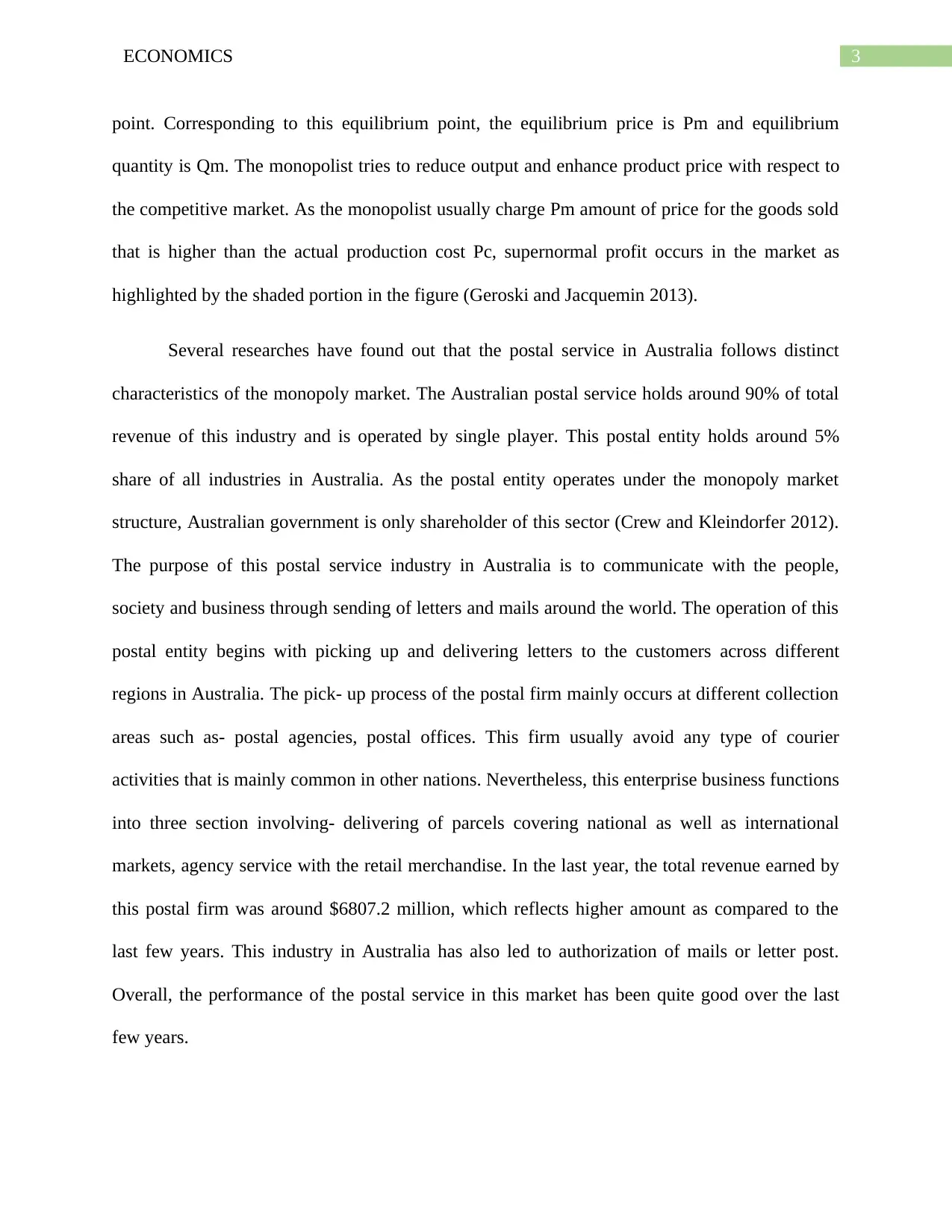
3ECONOMICS
point. Corresponding to this equilibrium point, the equilibrium price is Pm and equilibrium
quantity is Qm. The monopolist tries to reduce output and enhance product price with respect to
the competitive market. As the monopolist usually charge Pm amount of price for the goods sold
that is higher than the actual production cost Pc, supernormal profit occurs in the market as
highlighted by the shaded portion in the figure (Geroski and Jacquemin 2013).
Several researches have found out that the postal service in Australia follows distinct
characteristics of the monopoly market. The Australian postal service holds around 90% of total
revenue of this industry and is operated by single player. This postal entity holds around 5%
share of all industries in Australia. As the postal entity operates under the monopoly market
structure, Australian government is only shareholder of this sector (Crew and Kleindorfer 2012).
The purpose of this postal service industry in Australia is to communicate with the people,
society and business through sending of letters and mails around the world. The operation of this
postal entity begins with picking up and delivering letters to the customers across different
regions in Australia. The pick- up process of the postal firm mainly occurs at different collection
areas such as- postal agencies, postal offices. This firm usually avoid any type of courier
activities that is mainly common in other nations. Nevertheless, this enterprise business functions
into three section involving- delivering of parcels covering national as well as international
markets, agency service with the retail merchandise. In the last year, the total revenue earned by
this postal firm was around $6807.2 million, which reflects higher amount as compared to the
last few years. This industry in Australia has also led to authorization of mails or letter post.
Overall, the performance of the postal service in this market has been quite good over the last
few years.
point. Corresponding to this equilibrium point, the equilibrium price is Pm and equilibrium
quantity is Qm. The monopolist tries to reduce output and enhance product price with respect to
the competitive market. As the monopolist usually charge Pm amount of price for the goods sold
that is higher than the actual production cost Pc, supernormal profit occurs in the market as
highlighted by the shaded portion in the figure (Geroski and Jacquemin 2013).
Several researches have found out that the postal service in Australia follows distinct
characteristics of the monopoly market. The Australian postal service holds around 90% of total
revenue of this industry and is operated by single player. This postal entity holds around 5%
share of all industries in Australia. As the postal entity operates under the monopoly market
structure, Australian government is only shareholder of this sector (Crew and Kleindorfer 2012).
The purpose of this postal service industry in Australia is to communicate with the people,
society and business through sending of letters and mails around the world. The operation of this
postal entity begins with picking up and delivering letters to the customers across different
regions in Australia. The pick- up process of the postal firm mainly occurs at different collection
areas such as- postal agencies, postal offices. This firm usually avoid any type of courier
activities that is mainly common in other nations. Nevertheless, this enterprise business functions
into three section involving- delivering of parcels covering national as well as international
markets, agency service with the retail merchandise. In the last year, the total revenue earned by
this postal firm was around $6807.2 million, which reflects higher amount as compared to the
last few years. This industry in Australia has also led to authorization of mails or letter post.
Overall, the performance of the postal service in this market has been quite good over the last
few years.
Paraphrase This Document
Need a fresh take? Get an instant paraphrase of this document with our AI Paraphraser
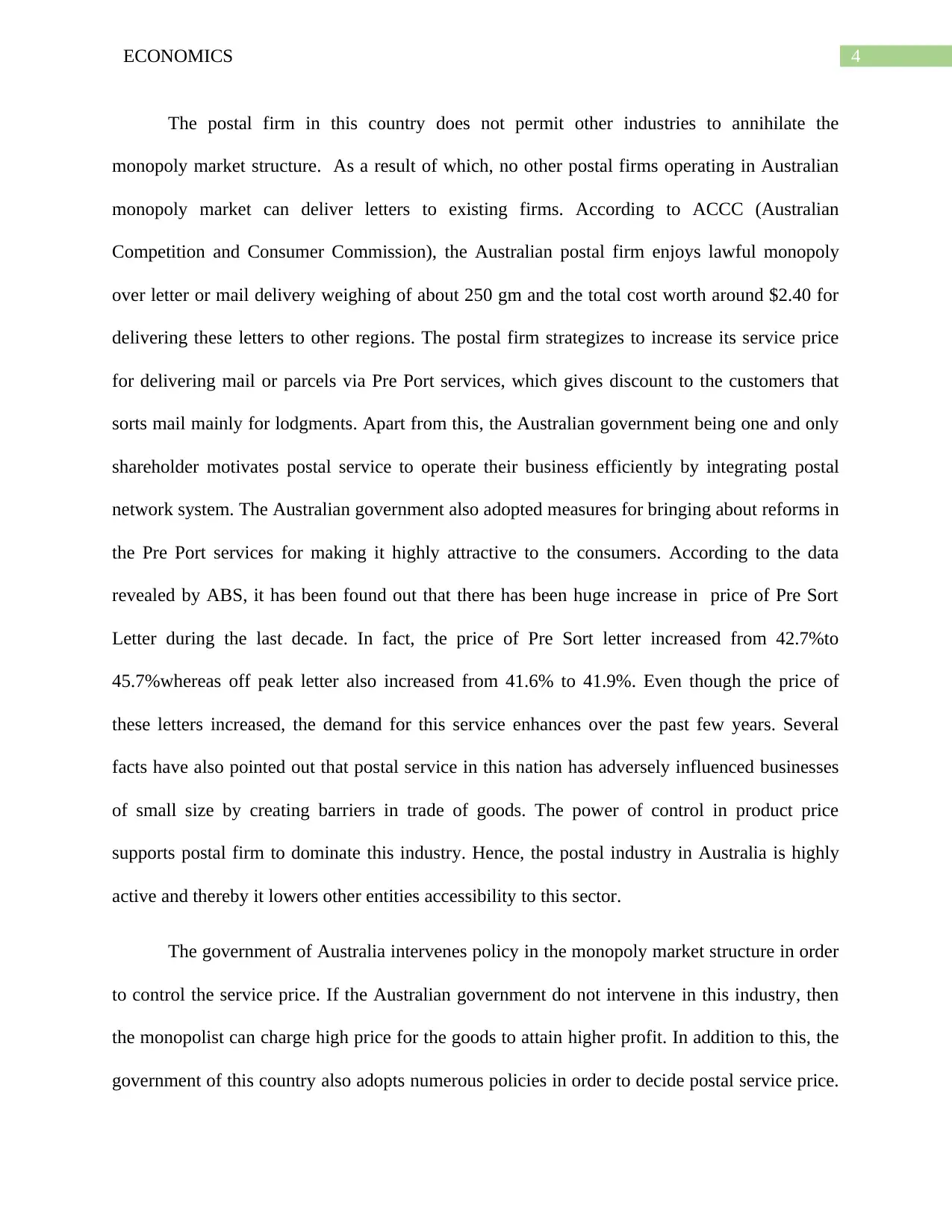
4ECONOMICS
The postal firm in this country does not permit other industries to annihilate the
monopoly market structure. As a result of which, no other postal firms operating in Australian
monopoly market can deliver letters to existing firms. According to ACCC (Australian
Competition and Consumer Commission), the Australian postal firm enjoys lawful monopoly
over letter or mail delivery weighing of about 250 gm and the total cost worth around $2.40 for
delivering these letters to other regions. The postal firm strategizes to increase its service price
for delivering mail or parcels via Pre Port services, which gives discount to the customers that
sorts mail mainly for lodgments. Apart from this, the Australian government being one and only
shareholder motivates postal service to operate their business efficiently by integrating postal
network system. The Australian government also adopted measures for bringing about reforms in
the Pre Port services for making it highly attractive to the consumers. According to the data
revealed by ABS, it has been found out that there has been huge increase in price of Pre Sort
Letter during the last decade. In fact, the price of Pre Sort letter increased from 42.7%to
45.7%whereas off peak letter also increased from 41.6% to 41.9%. Even though the price of
these letters increased, the demand for this service enhances over the past few years. Several
facts have also pointed out that postal service in this nation has adversely influenced businesses
of small size by creating barriers in trade of goods. The power of control in product price
supports postal firm to dominate this industry. Hence, the postal industry in Australia is highly
active and thereby it lowers other entities accessibility to this sector.
The government of Australia intervenes policy in the monopoly market structure in order
to control the service price. If the Australian government do not intervene in this industry, then
the monopolist can charge high price for the goods to attain higher profit. In addition to this, the
government of this country also adopts numerous policies in order to decide postal service price.
The postal firm in this country does not permit other industries to annihilate the
monopoly market structure. As a result of which, no other postal firms operating in Australian
monopoly market can deliver letters to existing firms. According to ACCC (Australian
Competition and Consumer Commission), the Australian postal firm enjoys lawful monopoly
over letter or mail delivery weighing of about 250 gm and the total cost worth around $2.40 for
delivering these letters to other regions. The postal firm strategizes to increase its service price
for delivering mail or parcels via Pre Port services, which gives discount to the customers that
sorts mail mainly for lodgments. Apart from this, the Australian government being one and only
shareholder motivates postal service to operate their business efficiently by integrating postal
network system. The Australian government also adopted measures for bringing about reforms in
the Pre Port services for making it highly attractive to the consumers. According to the data
revealed by ABS, it has been found out that there has been huge increase in price of Pre Sort
Letter during the last decade. In fact, the price of Pre Sort letter increased from 42.7%to
45.7%whereas off peak letter also increased from 41.6% to 41.9%. Even though the price of
these letters increased, the demand for this service enhances over the past few years. Several
facts have also pointed out that postal service in this nation has adversely influenced businesses
of small size by creating barriers in trade of goods. The power of control in product price
supports postal firm to dominate this industry. Hence, the postal industry in Australia is highly
active and thereby it lowers other entities accessibility to this sector.
The government of Australia intervenes policy in the monopoly market structure in order
to control the service price. If the Australian government do not intervene in this industry, then
the monopolist can charge high price for the goods to attain higher profit. In addition to this, the
government of this country also adopts numerous policies in order to decide postal service price.

5ECONOMICS
The business practice within this industry reduces the total amount of the consumer surplus and
thus intervention of Australian government help this postal entity to utilize its resources
effectively. However, the intervention of this nation’s government mainly leads to better
outcome as it protects the interest of customers those who depends on postal service. This
situation is described in the diagram shown below-
Figure 2: Intervention of government within the monopoly market
Source : (As created by Author)
The diagram drawn above reflects the intervention of the Australian government within
the postal industry. The price of postal service charged by postal entity is shown by P1 level
before the policy intervention set by the Australian government. Due to this policy intervention,
the Australian government has reduced the price of postal service in the year 2017 from P1 to P2
level. Owing to this, the amount of profit that this postal sector obtains declines to specific
extent.
Australia’s Monopolistic competitive market
The business practice within this industry reduces the total amount of the consumer surplus and
thus intervention of Australian government help this postal entity to utilize its resources
effectively. However, the intervention of this nation’s government mainly leads to better
outcome as it protects the interest of customers those who depends on postal service. This
situation is described in the diagram shown below-
Figure 2: Intervention of government within the monopoly market
Source : (As created by Author)
The diagram drawn above reflects the intervention of the Australian government within
the postal industry. The price of postal service charged by postal entity is shown by P1 level
before the policy intervention set by the Australian government. Due to this policy intervention,
the Australian government has reduced the price of postal service in the year 2017 from P1 to P2
level. Owing to this, the amount of profit that this postal sector obtains declines to specific
extent.
Australia’s Monopolistic competitive market
⊘ This is a preview!⊘
Do you want full access?
Subscribe today to unlock all pages.

Trusted by 1+ million students worldwide
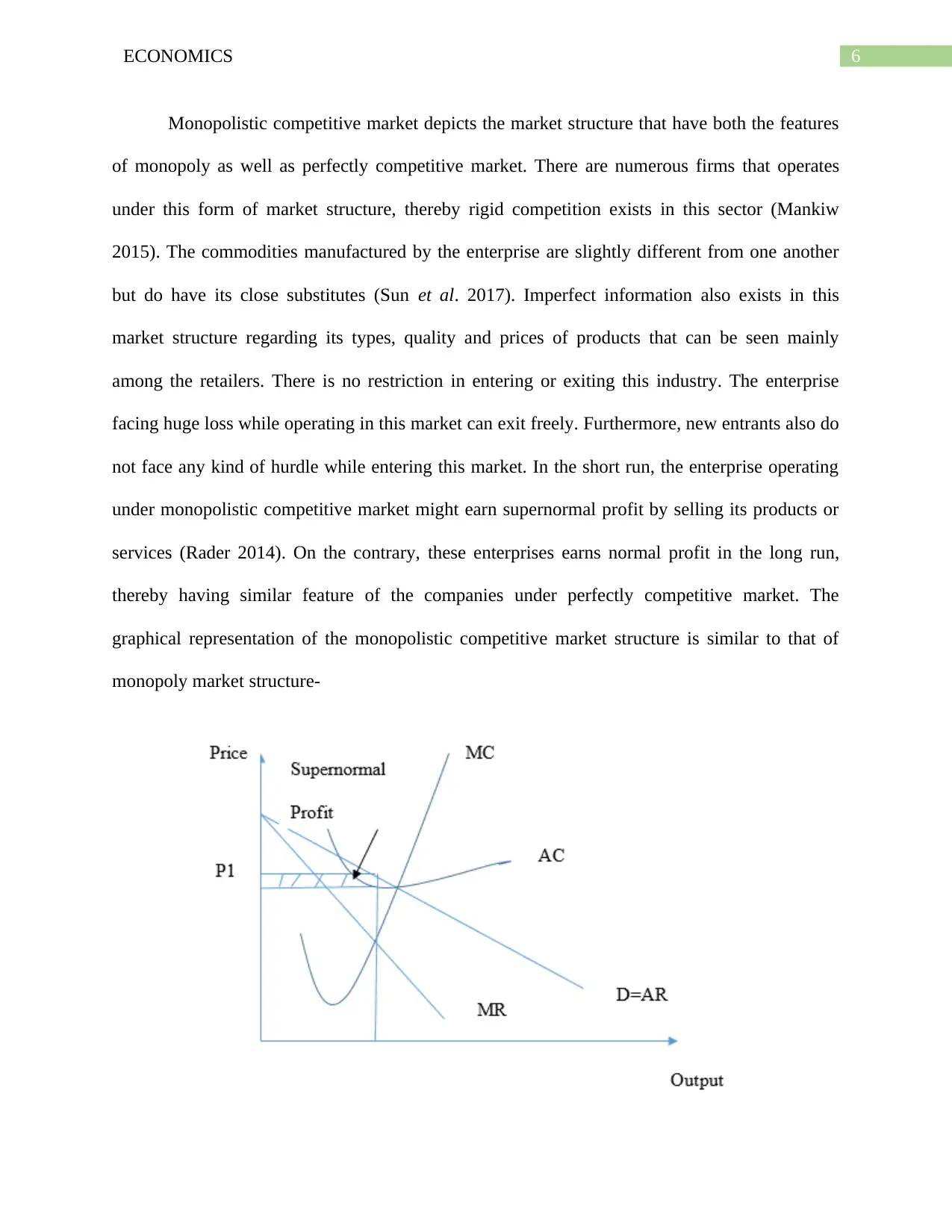
6ECONOMICS
Monopolistic competitive market depicts the market structure that have both the features
of monopoly as well as perfectly competitive market. There are numerous firms that operates
under this form of market structure, thereby rigid competition exists in this sector (Mankiw
2015). The commodities manufactured by the enterprise are slightly different from one another
but do have its close substitutes (Sun et al. 2017). Imperfect information also exists in this
market structure regarding its types, quality and prices of products that can be seen mainly
among the retailers. There is no restriction in entering or exiting this industry. The enterprise
facing huge loss while operating in this market can exit freely. Furthermore, new entrants also do
not face any kind of hurdle while entering this market. In the short run, the enterprise operating
under monopolistic competitive market might earn supernormal profit by selling its products or
services (Rader 2014). On the contrary, these enterprises earns normal profit in the long run,
thereby having similar feature of the companies under perfectly competitive market. The
graphical representation of the monopolistic competitive market structure is similar to that of
monopoly market structure-
Monopolistic competitive market depicts the market structure that have both the features
of monopoly as well as perfectly competitive market. There are numerous firms that operates
under this form of market structure, thereby rigid competition exists in this sector (Mankiw
2015). The commodities manufactured by the enterprise are slightly different from one another
but do have its close substitutes (Sun et al. 2017). Imperfect information also exists in this
market structure regarding its types, quality and prices of products that can be seen mainly
among the retailers. There is no restriction in entering or exiting this industry. The enterprise
facing huge loss while operating in this market can exit freely. Furthermore, new entrants also do
not face any kind of hurdle while entering this market. In the short run, the enterprise operating
under monopolistic competitive market might earn supernormal profit by selling its products or
services (Rader 2014). On the contrary, these enterprises earns normal profit in the long run,
thereby having similar feature of the companies under perfectly competitive market. The
graphical representation of the monopolistic competitive market structure is similar to that of
monopoly market structure-
Paraphrase This Document
Need a fresh take? Get an instant paraphrase of this document with our AI Paraphraser
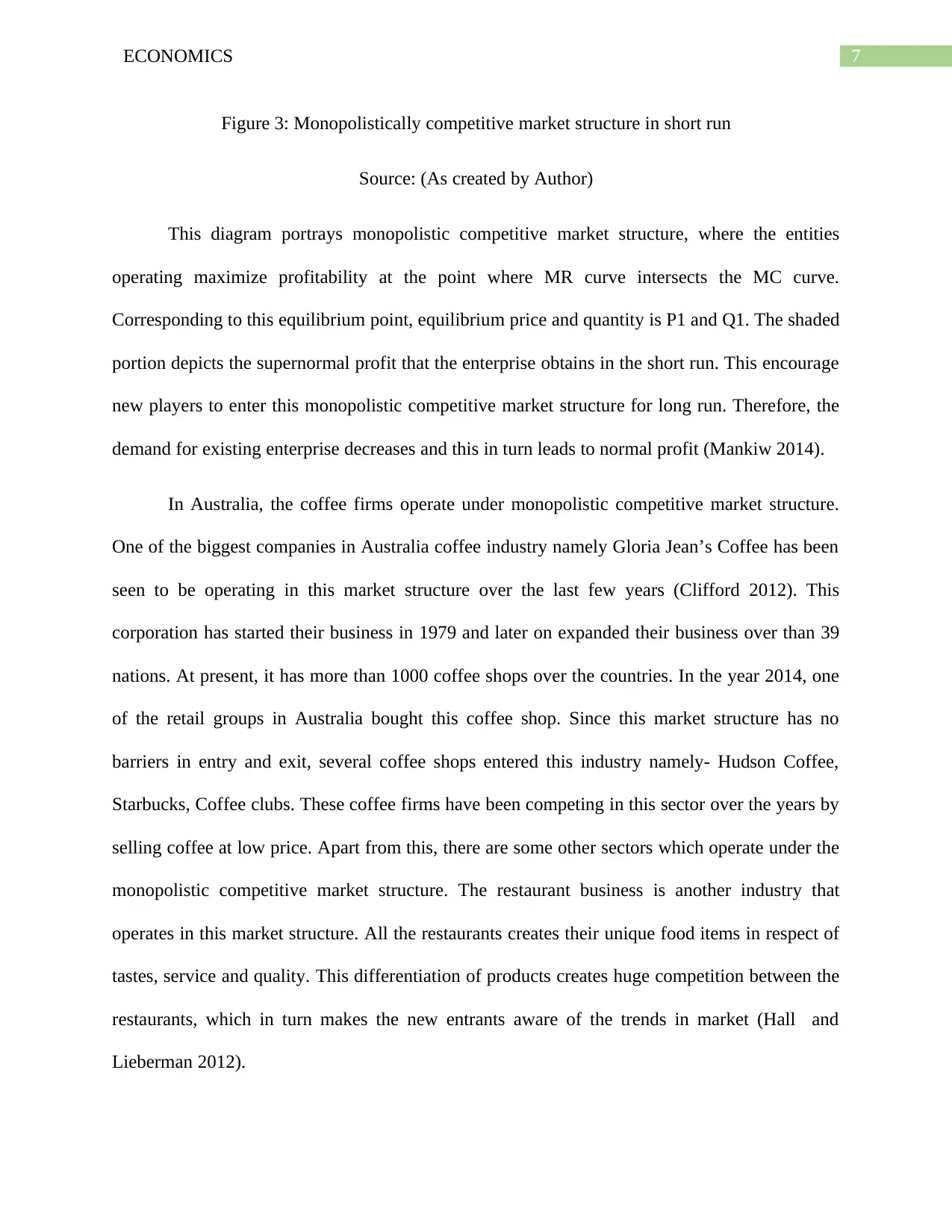
7ECONOMICS
Figure 3: Monopolistically competitive market structure in short run
Source: (As created by Author)
This diagram portrays monopolistic competitive market structure, where the entities
operating maximize profitability at the point where MR curve intersects the MC curve.
Corresponding to this equilibrium point, equilibrium price and quantity is P1 and Q1. The shaded
portion depicts the supernormal profit that the enterprise obtains in the short run. This encourage
new players to enter this monopolistic competitive market structure for long run. Therefore, the
demand for existing enterprise decreases and this in turn leads to normal profit (Mankiw 2014).
In Australia, the coffee firms operate under monopolistic competitive market structure.
One of the biggest companies in Australia coffee industry namely Gloria Jean’s Coffee has been
seen to be operating in this market structure over the last few years (Clifford 2012). This
corporation has started their business in 1979 and later on expanded their business over than 39
nations. At present, it has more than 1000 coffee shops over the countries. In the year 2014, one
of the retail groups in Australia bought this coffee shop. Since this market structure has no
barriers in entry and exit, several coffee shops entered this industry namely- Hudson Coffee,
Starbucks, Coffee clubs. These coffee firms have been competing in this sector over the years by
selling coffee at low price. Apart from this, there are some other sectors which operate under the
monopolistic competitive market structure. The restaurant business is another industry that
operates in this market structure. All the restaurants creates their unique food items in respect of
tastes, service and quality. This differentiation of products creates huge competition between the
restaurants, which in turn makes the new entrants aware of the trends in market (Hall and
Lieberman 2012).
Figure 3: Monopolistically competitive market structure in short run
Source: (As created by Author)
This diagram portrays monopolistic competitive market structure, where the entities
operating maximize profitability at the point where MR curve intersects the MC curve.
Corresponding to this equilibrium point, equilibrium price and quantity is P1 and Q1. The shaded
portion depicts the supernormal profit that the enterprise obtains in the short run. This encourage
new players to enter this monopolistic competitive market structure for long run. Therefore, the
demand for existing enterprise decreases and this in turn leads to normal profit (Mankiw 2014).
In Australia, the coffee firms operate under monopolistic competitive market structure.
One of the biggest companies in Australia coffee industry namely Gloria Jean’s Coffee has been
seen to be operating in this market structure over the last few years (Clifford 2012). This
corporation has started their business in 1979 and later on expanded their business over than 39
nations. At present, it has more than 1000 coffee shops over the countries. In the year 2014, one
of the retail groups in Australia bought this coffee shop. Since this market structure has no
barriers in entry and exit, several coffee shops entered this industry namely- Hudson Coffee,
Starbucks, Coffee clubs. These coffee firms have been competing in this sector over the years by
selling coffee at low price. Apart from this, there are some other sectors which operate under the
monopolistic competitive market structure. The restaurant business is another industry that
operates in this market structure. All the restaurants creates their unique food items in respect of
tastes, service and quality. This differentiation of products creates huge competition between the
restaurants, which in turn makes the new entrants aware of the trends in market (Hall and
Lieberman 2012).
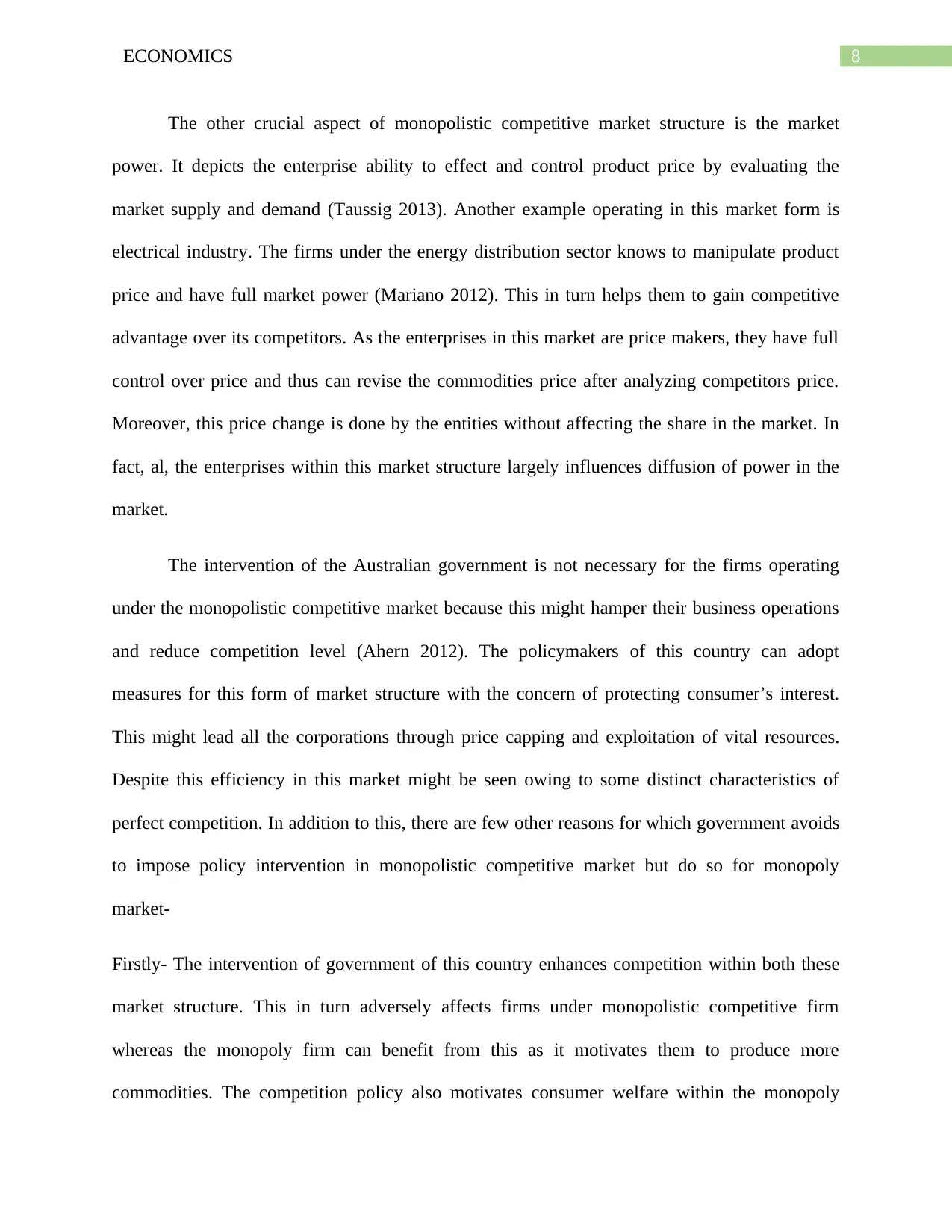
8ECONOMICS
The other crucial aspect of monopolistic competitive market structure is the market
power. It depicts the enterprise ability to effect and control product price by evaluating the
market supply and demand (Taussig 2013). Another example operating in this market form is
electrical industry. The firms under the energy distribution sector knows to manipulate product
price and have full market power (Mariano 2012). This in turn helps them to gain competitive
advantage over its competitors. As the enterprises in this market are price makers, they have full
control over price and thus can revise the commodities price after analyzing competitors price.
Moreover, this price change is done by the entities without affecting the share in the market. In
fact, al, the enterprises within this market structure largely influences diffusion of power in the
market.
The intervention of the Australian government is not necessary for the firms operating
under the monopolistic competitive market because this might hamper their business operations
and reduce competition level (Ahern 2012). The policymakers of this country can adopt
measures for this form of market structure with the concern of protecting consumer’s interest.
This might lead all the corporations through price capping and exploitation of vital resources.
Despite this efficiency in this market might be seen owing to some distinct characteristics of
perfect competition. In addition to this, there are few other reasons for which government avoids
to impose policy intervention in monopolistic competitive market but do so for monopoly
market-
Firstly- The intervention of government of this country enhances competition within both these
market structure. This in turn adversely affects firms under monopolistic competitive firm
whereas the monopoly firm can benefit from this as it motivates them to produce more
commodities. The competition policy also motivates consumer welfare within the monopoly
The other crucial aspect of monopolistic competitive market structure is the market
power. It depicts the enterprise ability to effect and control product price by evaluating the
market supply and demand (Taussig 2013). Another example operating in this market form is
electrical industry. The firms under the energy distribution sector knows to manipulate product
price and have full market power (Mariano 2012). This in turn helps them to gain competitive
advantage over its competitors. As the enterprises in this market are price makers, they have full
control over price and thus can revise the commodities price after analyzing competitors price.
Moreover, this price change is done by the entities without affecting the share in the market. In
fact, al, the enterprises within this market structure largely influences diffusion of power in the
market.
The intervention of the Australian government is not necessary for the firms operating
under the monopolistic competitive market because this might hamper their business operations
and reduce competition level (Ahern 2012). The policymakers of this country can adopt
measures for this form of market structure with the concern of protecting consumer’s interest.
This might lead all the corporations through price capping and exploitation of vital resources.
Despite this efficiency in this market might be seen owing to some distinct characteristics of
perfect competition. In addition to this, there are few other reasons for which government avoids
to impose policy intervention in monopolistic competitive market but do so for monopoly
market-
Firstly- The intervention of government of this country enhances competition within both these
market structure. This in turn adversely affects firms under monopolistic competitive firm
whereas the monopoly firm can benefit from this as it motivates them to produce more
commodities. The competition policy also motivates consumer welfare within the monopoly
⊘ This is a preview!⊘
Do you want full access?
Subscribe today to unlock all pages.

Trusted by 1+ million students worldwide
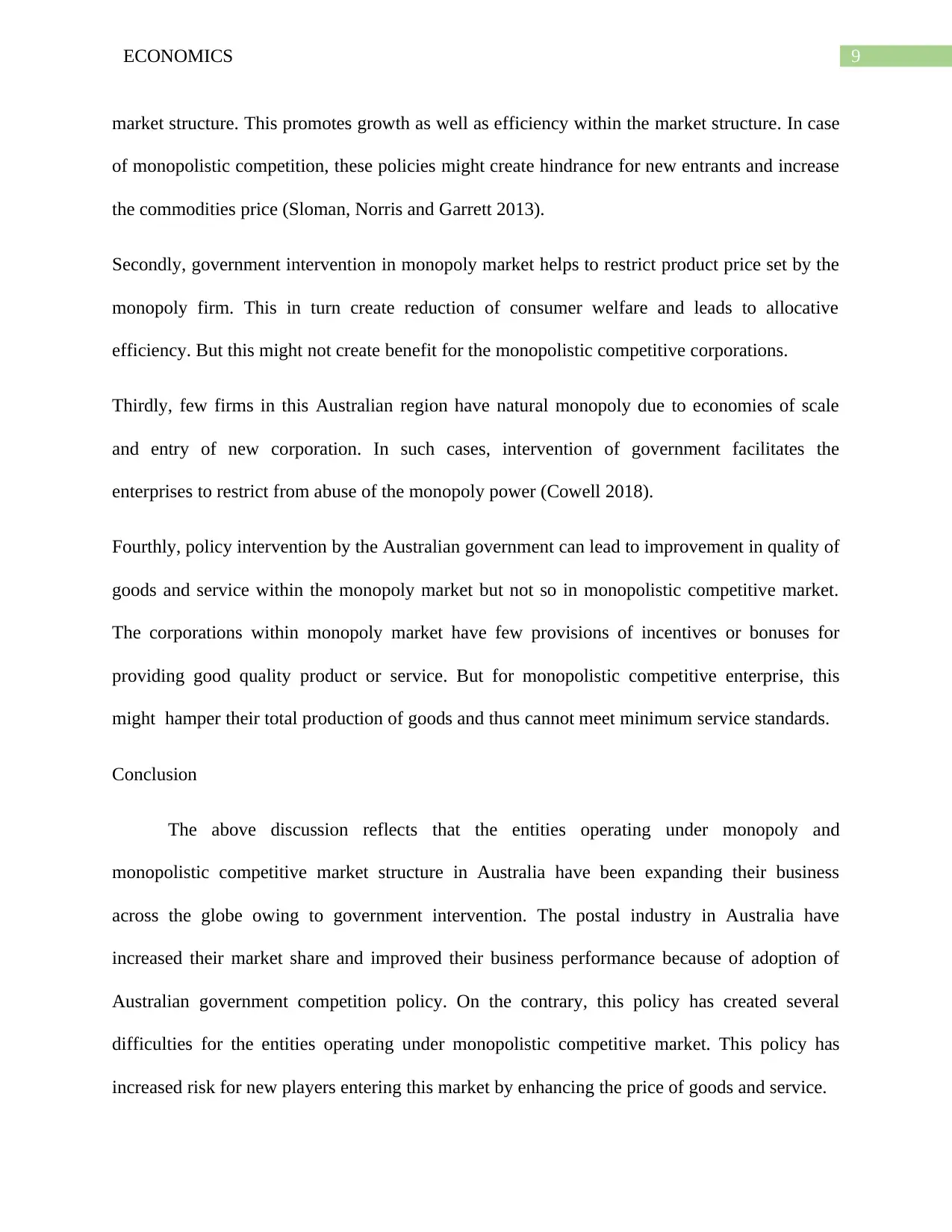
9ECONOMICS
market structure. This promotes growth as well as efficiency within the market structure. In case
of monopolistic competition, these policies might create hindrance for new entrants and increase
the commodities price (Sloman, Norris and Garrett 2013).
Secondly, government intervention in monopoly market helps to restrict product price set by the
monopoly firm. This in turn create reduction of consumer welfare and leads to allocative
efficiency. But this might not create benefit for the monopolistic competitive corporations.
Thirdly, few firms in this Australian region have natural monopoly due to economies of scale
and entry of new corporation. In such cases, intervention of government facilitates the
enterprises to restrict from abuse of the monopoly power (Cowell 2018).
Fourthly, policy intervention by the Australian government can lead to improvement in quality of
goods and service within the monopoly market but not so in monopolistic competitive market.
The corporations within monopoly market have few provisions of incentives or bonuses for
providing good quality product or service. But for monopolistic competitive enterprise, this
might hamper their total production of goods and thus cannot meet minimum service standards.
Conclusion
The above discussion reflects that the entities operating under monopoly and
monopolistic competitive market structure in Australia have been expanding their business
across the globe owing to government intervention. The postal industry in Australia have
increased their market share and improved their business performance because of adoption of
Australian government competition policy. On the contrary, this policy has created several
difficulties for the entities operating under monopolistic competitive market. This policy has
increased risk for new players entering this market by enhancing the price of goods and service.
market structure. This promotes growth as well as efficiency within the market structure. In case
of monopolistic competition, these policies might create hindrance for new entrants and increase
the commodities price (Sloman, Norris and Garrett 2013).
Secondly, government intervention in monopoly market helps to restrict product price set by the
monopoly firm. This in turn create reduction of consumer welfare and leads to allocative
efficiency. But this might not create benefit for the monopolistic competitive corporations.
Thirdly, few firms in this Australian region have natural monopoly due to economies of scale
and entry of new corporation. In such cases, intervention of government facilitates the
enterprises to restrict from abuse of the monopoly power (Cowell 2018).
Fourthly, policy intervention by the Australian government can lead to improvement in quality of
goods and service within the monopoly market but not so in monopolistic competitive market.
The corporations within monopoly market have few provisions of incentives or bonuses for
providing good quality product or service. But for monopolistic competitive enterprise, this
might hamper their total production of goods and thus cannot meet minimum service standards.
Conclusion
The above discussion reflects that the entities operating under monopoly and
monopolistic competitive market structure in Australia have been expanding their business
across the globe owing to government intervention. The postal industry in Australia have
increased their market share and improved their business performance because of adoption of
Australian government competition policy. On the contrary, this policy has created several
difficulties for the entities operating under monopolistic competitive market. This policy has
increased risk for new players entering this market by enhancing the price of goods and service.
Paraphrase This Document
Need a fresh take? Get an instant paraphrase of this document with our AI Paraphraser
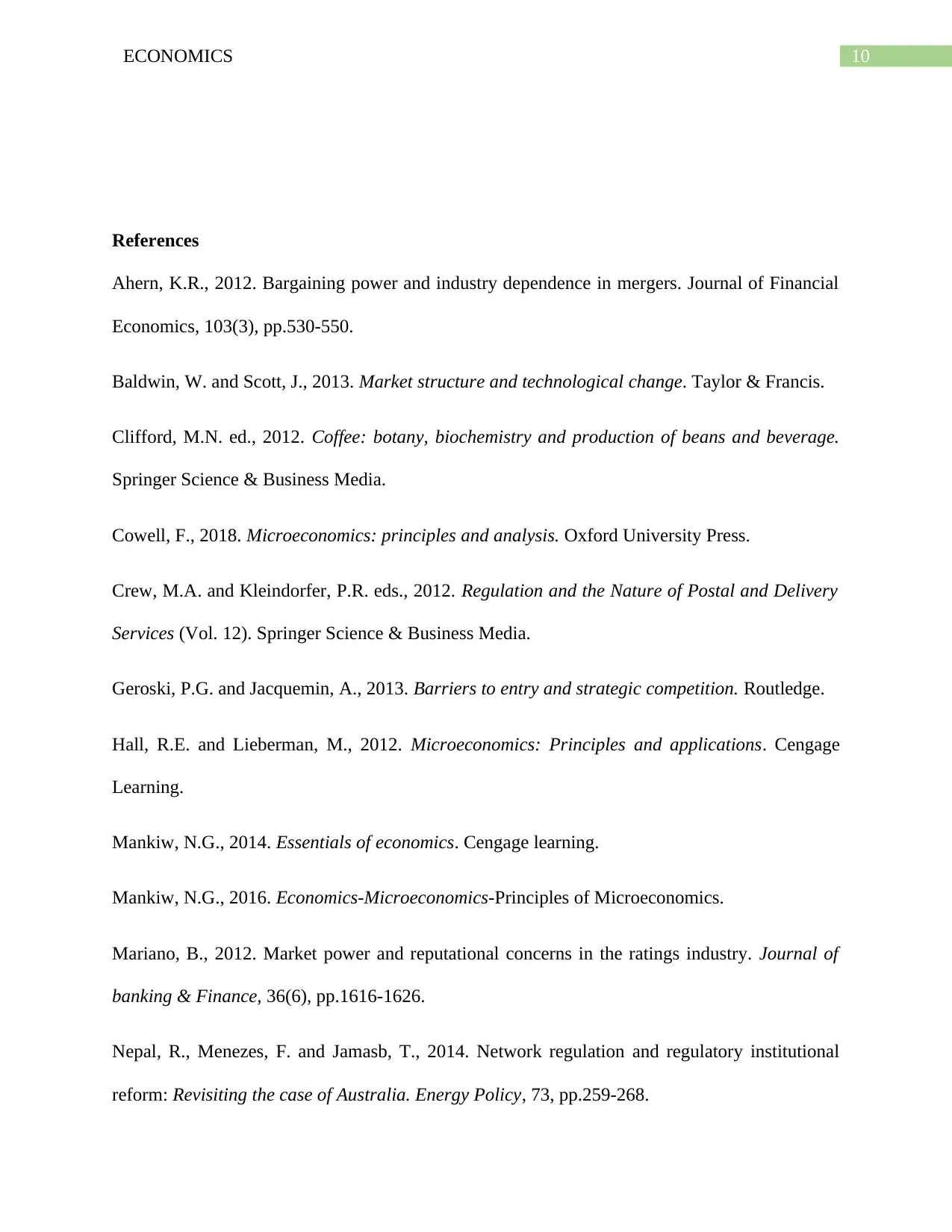
10ECONOMICS
References
Ahern, K.R., 2012. Bargaining power and industry dependence in mergers. Journal of Financial
Economics, 103(3), pp.530-550.
Baldwin, W. and Scott, J., 2013. Market structure and technological change. Taylor & Francis.
Clifford, M.N. ed., 2012. Coffee: botany, biochemistry and production of beans and beverage.
Springer Science & Business Media.
Cowell, F., 2018. Microeconomics: principles and analysis. Oxford University Press.
Crew, M.A. and Kleindorfer, P.R. eds., 2012. Regulation and the Nature of Postal and Delivery
Services (Vol. 12). Springer Science & Business Media.
Geroski, P.G. and Jacquemin, A., 2013. Barriers to entry and strategic competition. Routledge.
Hall, R.E. and Lieberman, M., 2012. Microeconomics: Principles and applications. Cengage
Learning.
Mankiw, N.G., 2014. Essentials of economics. Cengage learning.
Mankiw, N.G., 2016. Economics-Microeconomics-Principles of Microeconomics.
Mariano, B., 2012. Market power and reputational concerns in the ratings industry. Journal of
banking & Finance, 36(6), pp.1616-1626.
Nepal, R., Menezes, F. and Jamasb, T., 2014. Network regulation and regulatory institutional
reform: Revisiting the case of Australia. Energy Policy, 73, pp.259-268.
References
Ahern, K.R., 2012. Bargaining power and industry dependence in mergers. Journal of Financial
Economics, 103(3), pp.530-550.
Baldwin, W. and Scott, J., 2013. Market structure and technological change. Taylor & Francis.
Clifford, M.N. ed., 2012. Coffee: botany, biochemistry and production of beans and beverage.
Springer Science & Business Media.
Cowell, F., 2018. Microeconomics: principles and analysis. Oxford University Press.
Crew, M.A. and Kleindorfer, P.R. eds., 2012. Regulation and the Nature of Postal and Delivery
Services (Vol. 12). Springer Science & Business Media.
Geroski, P.G. and Jacquemin, A., 2013. Barriers to entry and strategic competition. Routledge.
Hall, R.E. and Lieberman, M., 2012. Microeconomics: Principles and applications. Cengage
Learning.
Mankiw, N.G., 2014. Essentials of economics. Cengage learning.
Mankiw, N.G., 2016. Economics-Microeconomics-Principles of Microeconomics.
Mariano, B., 2012. Market power and reputational concerns in the ratings industry. Journal of
banking & Finance, 36(6), pp.1616-1626.
Nepal, R., Menezes, F. and Jamasb, T., 2014. Network regulation and regulatory institutional
reform: Revisiting the case of Australia. Energy Policy, 73, pp.259-268.
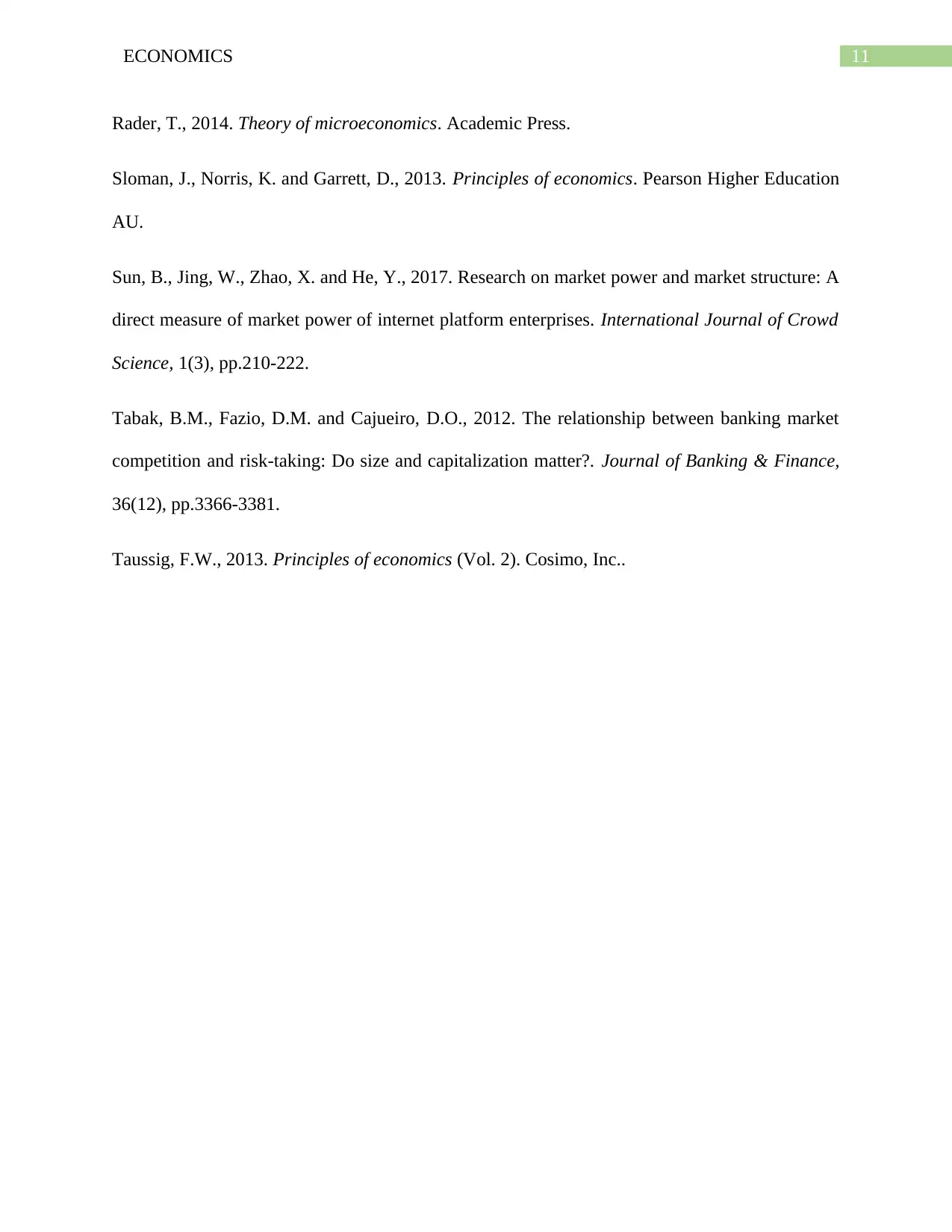
11ECONOMICS
Rader, T., 2014. Theory of microeconomics. Academic Press.
Sloman, J., Norris, K. and Garrett, D., 2013. Principles of economics. Pearson Higher Education
AU.
Sun, B., Jing, W., Zhao, X. and He, Y., 2017. Research on market power and market structure: A
direct measure of market power of internet platform enterprises. International Journal of Crowd
Science, 1(3), pp.210-222.
Tabak, B.M., Fazio, D.M. and Cajueiro, D.O., 2012. The relationship between banking market
competition and risk-taking: Do size and capitalization matter?. Journal of Banking & Finance,
36(12), pp.3366-3381.
Taussig, F.W., 2013. Principles of economics (Vol. 2). Cosimo, Inc..
Rader, T., 2014. Theory of microeconomics. Academic Press.
Sloman, J., Norris, K. and Garrett, D., 2013. Principles of economics. Pearson Higher Education
AU.
Sun, B., Jing, W., Zhao, X. and He, Y., 2017. Research on market power and market structure: A
direct measure of market power of internet platform enterprises. International Journal of Crowd
Science, 1(3), pp.210-222.
Tabak, B.M., Fazio, D.M. and Cajueiro, D.O., 2012. The relationship between banking market
competition and risk-taking: Do size and capitalization matter?. Journal of Banking & Finance,
36(12), pp.3366-3381.
Taussig, F.W., 2013. Principles of economics (Vol. 2). Cosimo, Inc..
⊘ This is a preview!⊘
Do you want full access?
Subscribe today to unlock all pages.

Trusted by 1+ million students worldwide
1 out of 12
Related Documents
Your All-in-One AI-Powered Toolkit for Academic Success.
+13062052269
info@desklib.com
Available 24*7 on WhatsApp / Email
![[object Object]](/_next/static/media/star-bottom.7253800d.svg)
Unlock your academic potential
Copyright © 2020–2025 A2Z Services. All Rights Reserved. Developed and managed by ZUCOL.





